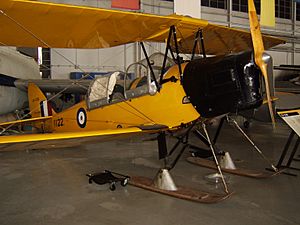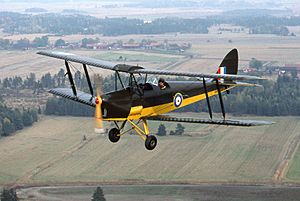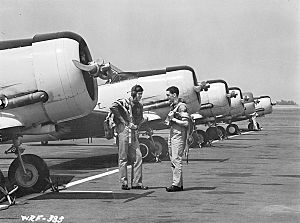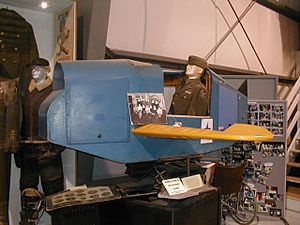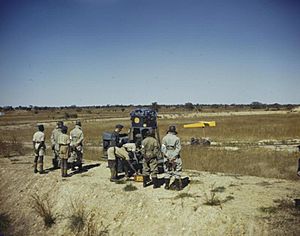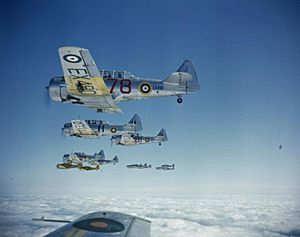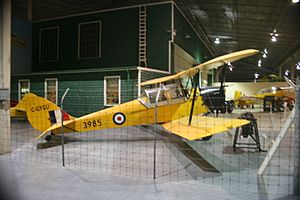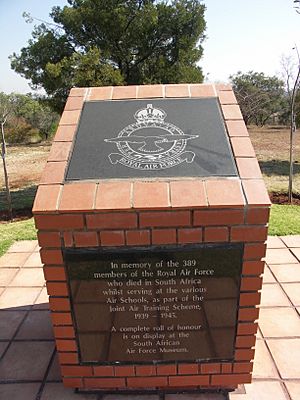British Commonwealth Air Training Plan facts for kids
Quick facts for kids British Commonwealth Air Training Plan |
|
|---|---|
| Part of the Second World War | |
| Australia, Canada, New Zealand, South Africa, Southern Rhodesia, United States | |

RCAF Harvard
|
|
| Site history | |
| In use | 1939–45 |
The British Commonwealth Air Training Plan (BCATP) was a huge program during World War II. It was also called the Empire Air Training Scheme. This plan helped train many thousands of aircrew members for the Royal Air Force (RAF) and other Allied air forces.
The United Kingdom, Canada, Australia, and New Zealand worked together to create this program. It was one of the biggest aviation training programs ever. Nearly half of all the pilots, navigators, and gunners who fought in the war were trained through this plan.
Many students from other countries also joined. These included Belgium, Czechoslovakia, Greece, the Netherlands, and the United States. South Africa had a similar plan called the Joint Air Training Scheme. They trained over 33,000 aircrew. Canada trained the most, with over 131,000 people.
Contents
Why Was It Needed?
The United Kingdom was not a safe place for air training during the war. Enemy attacks were a big risk. Also, the weather was often bad, and airfields were very busy. So, the plan decided to use training facilities in other Commonwealth countries.
Leaders from the four main governments met in Ottawa, Canada. They signed an agreement on December 17, 1939. This agreement was known as the "Riverdale Agreement."
The British Commonwealth Air Training Plan was a very ambitious idea. It aimed to train about 50,000 aircrew every year. This included people from Great Britain, Canada, Australia, and New Zealand. Trainees would get basic training in their home countries. Then, they would often go to Canada for more advanced courses. The costs were shared among the four governments.
The first Canadian training course started on April 29, 1940. It had 221 recruits. Many of these early graduates stayed in Canada as instructors. The first group of BCATP personnel sent to the UK were Canadian observers in October 1940.
Countries That Helped
Many countries were involved in this massive training effort. Each played a vital role in preparing aircrew for the war.
Australia's Contribution
Before this plan, Australia's air force (RAAF) trained only about 50 pilots a year. Under the new scheme, Australia promised to train 28,000 aircrew over three years. By 1945, over 37,500 Australian aircrew had been trained. Most of them finished their training in Australia.
RAAF schools were set up all over Australia. They taught initial training, flying, navigation, and gunnery. The first flying course began on April 29, 1940.
After the Pacific War started in December 1941, most RAAF aircrew finished their training in Australia. They then served in the Pacific region. However, many Australians still fought in Europe.
Bermuda's Role
The British colony of Bermuda also helped. They created the Bermuda Flying School in 1940. This school trained local pilots for the RAF. It used seaplanes and was located at an RAF air station.
The school was led by Major Cecil Montgomery-Moore. Students had to be part of the local army units. By 1942, 80 pilots had been sent to the RAF. The school then became a recruiting office for the Royal Canadian Air Force (RCAF).
Canada's Big Role
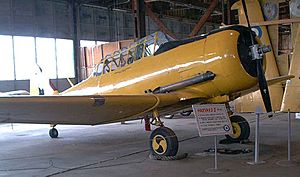

Canada was chosen as the main training location. It had ideal weather and wide-open spaces for flying. Canada also had plenty of fuel and factories to make planes. There was no threat of enemy attacks there.
Canada agreed to host the plan and pay most of the costs. This became a huge operation. It cost Canada $1.6 billion and employed 104,000 Canadians. The Canadian government wanted to keep Canadians at home. This plan helped avoid sending a large army overseas.
The RCAF ran the plan in Canada. A senior RAF commander, Robert Leckie, helped direct the training.
At its busiest, the BCATP trained 131,533 Allied pilots and aircrew in Canada. Over 72,000 of these were Canadian. In late 1943, over 100,000 people worked at 107 schools across Canada. They built thousands of buildings and miles of runways.
The plan ended in late 1944 because there were enough aircrews. By March 1945, over 167,000 students had trained in Canada.
New Zealand's Part
New Zealand's air force (RNZAF) trained 2,743 pilots for the RAF. These pilots served in Europe, the Middle East, and the Far East. Another 1,521 pilots trained in New Zealand stayed there as instructors.
New Zealand also trained observers and air gunners. From 1943, they trained wireless operators and navigators for Pacific operations. Many New Zealanders went to Canada for advanced training. New Zealanders made up 5.3% of all trainees who graduated in Canada.
South Africa's Training
South Africa also had a training program called the Joint Air Training Scheme (JATS). Many new flying schools were set up. The United Kingdom provided planes and equipment for free.
By September 1941, South Africa had 1,709 military aircraft and over 31,000 personnel. The JATS trained 33,347 aircrew in five years. This included 12,221 South African air force members.
Southern Rhodesia's Schools
When the war began, Southern Rhodesia offered to run a flying school. This became the Rhodesian Air Training Group (RATG). It was part of the larger Commonwealth Air Training Plan.
The RATG started in 1940. It set up schools in Salisbury, Bulawayo, and Gwelo. These schools could train many pilots, observers, and gunners each year. They also had special schools for instructors and navigators.
Trainees came from Great Britain, Australia, Canada, and many other countries. Over 7,600 pilots and 2,300 navigators were trained by the RATG during the war.
Help from the United States
In 1940, Canada started recruiting American pilots to be instructors. Air Marshal Billy Bishop helped set up a secret recruiting effort in the United States. At this time, the U.S. was still neutral.
Americans began crossing the border to join the RCAF or RAF. President Roosevelt allowed Americans to be exempt from the U.S. draft if they joined. By the end of the war, 16,000 RAF aircrew were trained in the United States. Many Americans later transferred to the U.S. armed forces.
What Was the Plan's Legacy?
The British Commonwealth Air Training Plan showed how strong the Commonwealth was during the war. It was one of Canada's biggest contributions to the war effort. It was a huge national success.
Canada became a major air training center. It trained over 130,000 aircrew for the Allies. The Canadian government paid most of the cost. President Roosevelt called Canada the "aerodrome of democracy."
Canada's Lasting Impact
The plan left a strong aviation industry in Canada after the war. Many new or improved airports were built across the country. Most of these airports are still used today.
A typical BCATP airport had three runways. They were usually 2,500 feet long and arranged in a triangle. This allowed planes to always land into the wind. This was important for older planes.
The BCATP also helped the economy in Western Canada. Many members of the RAF, RAAF, and RNZAF married Canadian girls. Many of them stayed in Canada to raise their families.
In 1959, Queen Elizabeth II unveiled The Ottawa Memorial. This monument honors the 800 men and women who died while training in Canada and nearby areas.
The Commonwealth Air Training Plan Museum in Brandon, Manitoba, is dedicated to this history. It has 14 aircraft on display.
The BCATP also led to other international air training programs in Canada. These include the NATO Air Training Plan and NATO Flying Training in Canada. The British Commonwealth Air Training Plan was named a National Historic Event in 1983.
South Africa's Memorials
The South African Air Force Memorial includes a tribute to RAF members. These members died in South Africa during the Joint Air Training Scheme.
The Port Elizabeth branch of the South African Air Force Museum is in an original training center. This center was used during the Joint Air Training Scheme.
Australia's Heritage
The training scheme cost Australia about £100,000,000. Australia built many air training schools and airfields. These helped the country during and after the war.
Many of the flying training schools were later closed. However, some remained. The Wireless Air Gunners' School at Ballarat became the RAAF Radio School.
Several former training schools are now on heritage lists. These include sites at Evans Head, Cunderdin, and Point Cook.
Images for kids
See also
- Article XV squadrons
- British Flying Training School Program
- Civilian Pilot Training Program of the United States
- List of British Commonwealth Air Training Plan facilities in Australia
- List of British Commonwealth Air Training Plan facilities in Canada
- List of British Commonwealth Air Training Plan facilities in South Africa
- List of British Commonwealth Air Training Plan facilities in Southern Rhodesia
- Category:Airports of the British Commonwealth Air Training Plan


